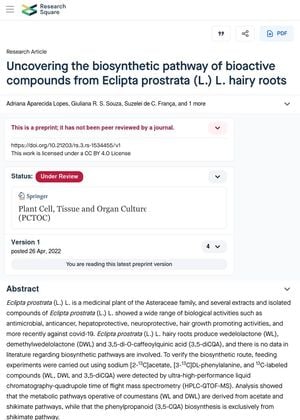Uncovering the Biosynthetic Pathway of Bioactive Compounds from Eclipta Prostrata Hairy Roots
April 2022
in “
Research Square (Research Square)
”

TLDR Scientists found out how a medicinal plant makes compounds with health benefits.
The medicinal plant Eclipta prostrata (L.) L., part of the Asteraceae family, produces compounds with a range of biological activities, including antimicrobial, anticancer, hepatoprotective, neuroprotective, and hair growth promoting activities. The plant's hairy roots produce wedelolactone (WL), demethylwedelolactone (DWL), and 3,5-di-O-caffeoylquinic acid (3,5-diCQA). To understand the biosynthetic pathways of these compounds, researchers conducted feeding experiments using sodium [2-13C]acetate, [3-13C]DL-phenylalanine, and detected 13C-labeled compounds (WL, DWL, and 3,5-diCQA) using ultra-high-performance liquid chromatography-quadrupole time of flight mass spectrometry (HPLC-QTOF-MS). The results showed that the metabolic pathways of coumestans (WL and DWL) are derived from both the acetate and shikimate pathways, while the phenylpropanoid (3,5-CQA) biosynthesis is exclusively from the shikimate pathway.
